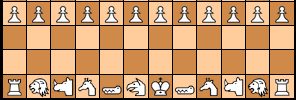Comments/Ratings for a Single Item
I noticed the old diagram positions started from illegal positions. I fixed that by creating new diagrams that use legal positions.
I came across this page because another page was trying to link to it with a bad link. While here, I noticed that it looked a mess with its Javascript graphics that used a separate image for each space. I replaced these with single images for each diagram, I edited the text, added new questions, and fixed the formatting so that the three cells in each table row will display vertically on mobile devices but still display horizontally on desktops.
Description of pawn move does not use standard terminology. A pawn does not make a 'double-step' move, it moves 2 squares.
A very easy to understand description of En Passant rule.. i had to visit several other pages to understand this rule but only here i understood how it works. Thanks
 Joe Joyce wrote on Fri, Mar 7, 2008 03:59 AM UTC:
Joe Joyce wrote on Fri, Mar 7, 2008 03:59 AM UTC:The purpose of the en passant rule is to give neighboring pawns one chance to capture. It doesn't make any difference which pawn gets that one chance to capture. In both the cases you mentioned, the pawn that just moved [the one that just double-stepped] could have captured the pawn that had moved up to a diagonally adjacent position, a pawns' mutual capture position, on a previous turn. Since the opportunity to capture was there, then the pawn that you are asking about cannot capture by an en passant move. Note that in a legal en passant move, the pawn moves 1 square diagonally forward, its standard capture move, whereas your suggested move would have the pawn capture with an orthogonally sideways move, one the pawn cannot make. I hope this answers your question adequately.
so what if you advance a pawn to a6 and the b7 pawn moves to b5, can you capture en passant? also i too would like an answer to the following previously posted question: I WANT TO ASK ABOUT THE SITUATION WHEN E2 MOVES TO E4 AND THERE IS A BLACK PAWN ON D3 , WHAT HAPPENS THEN ? I'LL BE THANKFULL FOR AN ANSWER . my email is: [email protected]
 Sid Montero wrote on Thu, Jan 31, 2008 01:23 PM UTC:
Sid Montero wrote on Thu, Jan 31, 2008 01:23 PM UTC:E Mail: [email protected]
 Ernie J wrote on Sun, Apr 8, 2007 12:03 AM UTC:Excellent ★★★★★
Ernie J wrote on Sun, Apr 8, 2007 12:03 AM UTC:Excellent ★★★★★I WANT TO ASK ABOUT THE SITUATION WHEN E2 MOVES TO E4 AND THERE IS A BLACK PAWN ON D3 , WHAT HAPPENS THEN ? I'LL BE THANKFULL FOR AN ANSWER . MY EMAIL : [email protected]
Regards,
Cathal
- Sam
25 comments displayed
Permalink to the exact comments currently displayed.

One reason to format a page for mobile first is that browsers on old mobile devices cannot be updated as easily as browsers on desktops, leaving some mobile browsers without the functionality of the most up-to-date browers. So, if the default formatting is suitable from a mobile device, it will look right even if that browsers is not up-todate. With that in mind, I replaced the tables used to display three diagrams in a row with flexboxes that will display them in a row only on browsers with up-to-date flexbox capability and a wide-enough screen to display them in a row. On older browsers or on smaller devices, it will display them in a column.